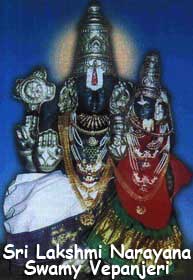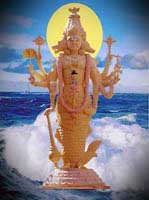Vepanjeri Sri Lakshmi Narayana Swamy Temple Timings: 6:00 AM to 9:00 PM
Vepanjeri Village, situated around 65 kms from the temple town of Tirupati and 15 kms from Chittoor, has a more colourful background than is known. “VEM PANCHA HARI” meaning the abode of the Lord who rids his devotee of the five grave sins’, gradually came to be known as today’s Vepanjeri.
About Sri Lakshmi Narayana Swamy Temple
Visistadwaita Philosophy believes that there are two forces governing the activities of Nature. While Lakshmi is the presiding deity for Nature, Lord Srimannarayana represents the basic consciousness and the motivating force behind the activity, be in physical, mental or spiritual. This school of thought sees two visible entities – Lakshmi and Narayana to form a single force. This is the reason for Vaishnaviate shrines having the idols of the Lord and the Goddess side by side.
Sri Lakshmi Narayana Swamy temple at Vepanjeri is one such. The presiding deity is Sri Lakshmi Narayana. His Consort, Sri Lakshmi Ammavaru on his left thigh controls effective dispensation of grace and divine providence. Lakshmi looking intently towards the face of Sri Lakshmi Narayana, as she is the instrument and efficacy through which prebendary benediction and prosperity are awarded. More and more devotees narrate the experience of the fulfillment of their wishes justifying the name KALPAVRUKSHA and Vepanjeri steadily emerged as sub-center for pilgrimage.

Turning to the pages of the history, one finds that the first reference of this temple was available in the 12th century (between 1178 and 1218), when Kulottunga III of the Chola dynasty was ruling this part of what used to be called as “Thondamandalam”.
Between 1216 AD and 1260, Raja Raja II had donned the mantle, and the period was known as an era of great disturbances with frequent wars becoming a mundane affairs.
During the reign of King Rajendra III (1246 – 1279), the region slipped into the hands of Telugu Pallavas from the Cholas, and Vijaya Ganda Gopala acted as the Governor for this region of Thondamandalam.
According to scriptures available, during the rule of Kulottunga III, either there was no royal patronage or it has been withdrawn. The locals, disturbed over the neglect of the temple, donated a piece of land and met its expenses from the proceeds of this land.
The first time, a ruler had paid attention to this ancient temple was during the Vijayanagara rule, when King Saluva Narasimha, as the regent of Chandragiri area, had extended the boundaries of his kingdom upto Vepanjeri.
There are evidences that he had stayed here in the year 1485 to worship the Lord. Between 14th and 15th centuries, when the French had ruled the region (presently in Karnataka and part of Andhra Pradesh), the temple was pushed to its nadir.
Between 1714 and 1880, Komandur Ramanuja Iyengar managed the temple, while members of the Madabhushi family were the priests. Even today, the descendants of the Komandur lineage are managing the temple trust.
In 1986, the temple was reconstructed for the first time by the Komandur family in the Pallava style of architecture, from the remains of what was supposed to be built by the Pallava rulers long ago, which speaks volumes of the continous neglect the temple had been subjected to. Ever since, pujas have been performed regularly and annual festivals (Brahmotsavams) held.
The Ashta Lakshmi Temple
A new attraction to this village is the recent Ashta Lakshmi temple said to be the first of its kind in the State. The temple complex comprises Lord Lakshmi Narayana with Kubera Lakshmi at the central complex, Goddess Lakshmi in eight postures, as Adi Lakshmi, Dhanya Lakshmi, Veera Lakshmi, Gaja Lakshmi, Santhana Lakshmi, Vijaya Lakshmi, Aishwarya Lakshmi, and Dhana Lakshmi housed in surrounding complexes. The nearest similar shrine is in Chennai on the brink of Elliots beach.
 The Viraat Swaroop
The Viraat Swaroop
Another significant feature of the village is the portrayal of Lord Vishnu’s supremacy over the world in the form is 21 feet depicting his “Dasavatharas” in one icon. The dominating height constituting an aggregate of 10 incarnations in a single statue along with the nature’s divisions of land, water, etc.
The Dasavathra Theertha
In the northeastern corner of the village, there is pushkarini, which is popularly called Dasavathara Theertha with statues of Kaleeya Mardhanam in the central mandapam;
Dasavatharas, Koneti Lakshmi Narayana, Sudharsana Chakra, Brahma, Vinayaka Muneeswara, Naga Prathishta, Gangamma and Saptha Kannikas around are attracting the devotees. They are all arte facts blended with figuring rays and sculptural elegance.
How To Reach Vepanjeri Temple:
From Tirupati – There are two routes – one, via Chittoor and G.D. Nellore; (90 K.M.) and another via Pachikapallam, Devalampet and G.D. Nellore (75 K.M.), APSRTC buses ply every half-an-hour.
From Chennai – one via Chittoor and G.D. Nellore (171 K.M.) and another via Tiruttani, R.K.Pet, Balija Kandriga and Thoogundram Village (140 K.M.)
From Bangalore – There are direct APSRTC buses plying to Balija Kandriga via Chittoor touching Vepanjeri.
